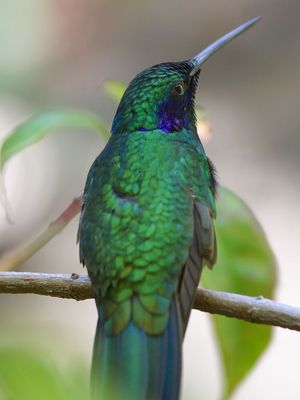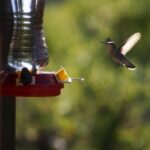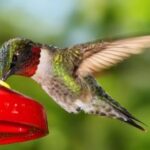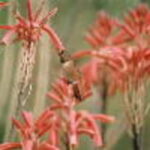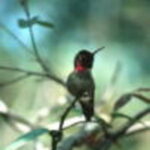Residents and visitors to Mississippi have the opportunity from March to October to enjoy the antics of at least ten species of hummingbirds as they enjoy the nectar and insects provided by feeders and hummingbird gardens. These ten species are Ruby-throated, Rufous, Buff-bellied, Black-chinned, White-eared, Calliope, Broad-tailed, Anna’s, Allen’s, and Green Violet-ear. With so many species arriving in Mississippi, it might be nice to be able to identify them.
The Ruby-throated Hummingbird is the most common hummingbird in the nation and consequently also in Mississippi. The male of this species is probably the easiest of all hummingbirds to identify. As its name implies, this hummingbird has a ruby-red throat, but it also has an emerald green back and a forked tail. The female Ruby-throated Hummingbird is quite differently marked than the male with the only trait that is the same being the emerald colored back. The rest of the female is quite different from its male counterpart with its breast and throat being white and its tail being rounded. One other characteristic that is different between the sexes is that the female Ruby-throated Hummingbird even has a longer bill than the male does.
The Rufous Hummingbird is another common species of hummingbirds found throughout the United States and certainly throughout Mississippi. Like the Ruby-throated hummingbird, this male is easier to identify than the female. The biggest outstanding trait this bird has is the bright-orange colored throat and white breast. The male Rufous Hummingbird also has rufous or rust colored feathers that cover his crown, tail and sides, thus giving them their name. The female Rufous Hummingbird has one feature in common with its male counterpart and that is its white breast. But, the female is different from the male in that that it has a green back and crown, a streaked throat and white-tipped, rufous colored tail feathers.
The Buff-bellied Hummingbird is a hummingbird that is somewhat unusual in that there is no difference in the coloration of the sexes as with other species of hummingbirds. The main difference between the sexes is that the male is a little bit larger than the female, weighing about 4.05g and females weighing about 3.67g. The Buff-bellied Hummingbird has a buff colored belly, hence the name, as well as buff or rust colored sides and tail feathers. Their back, crown and throat are covered with metallic green feathers. This species of hummingbird also has white-eye rings.
The Black-chinned Hummingbird is another species of hummingbird in Mississippi where the sexes are differently colored. The black throat, purple throat band and white collar are characteristics that help identify the male, as well as green feathers that cover its back, crown and breast. The female has white breast feathers, black spots on a white throat, buff feathers on its sides and the same green feathers covering its back and crown.
The White-eared Hummingbird is named by the most obvious characteristic, the prominent white ear stripes that found on both sexes. Both sexes also have a black tip on their red bill, but these two characteristics are where the similarities between the sexes end. The male White-eared Hummingbird has emerald green feathers that cover its back and breast, purple feathers that cover its crown and iridescent blue-green feathers that cover its chin. The female has less colorful green feathers covering its back and crown, white feathers covering its breast and white with green streaks on its sides.
The Calliope Hummingbird could be identified simply by its size; this is the smallest species of hummingbirds in Mississippi. But size alone should not be the only factor used when identifying Calliope Hummingbirds. Males can be identified by the purple rays throughout its white throat. It also has a metallic green covered back and crown. The female has a green back and crown but not a metallic green like the male. It also has dark streaks throughout its white throat and buff colored sides.
The Broad-tailed Hummingbird has an unusual trait to help identify it. This unusual trait is the cricket-sound the male makes with its wings while it is flying. Even though the Broad-tailed Hummingbird is the only hummingbird in Mississippi to make this sound, it can also be identified by its metallic green colored back and crown, white colored breast, rose colored throat and its tail feathers are rounded. The female Broad-tailed Hummingbird has a plain green colored back and crown, a throat that is white with black spots, rufous colored sides and their tail feathers are a combination of green, rufous and black with white tips.
The Allen’s Hummingbird is another species that is easier to identify the male than the female. To begin with, the throat of the male is covered with iridescent copper-red feathers and metallic-bronze-green feathers cover his head and back. Female Allen’s Hummingbirds are often confused with female Rufous Hummingbird due to the amount of rufous colored feathers that cover their back and sides. These hummingbirds differ though with their red spotted, white throat, their white breast and rounded, white-tipped tail feathers.
The Anna’s Hummingbird is one of the larger species of hummingbirds in Mississippi with the male weighing about 4.3 grams. Not only is the size of this bird one identifying trait, but also it has an actual song that most hummingbirds do not have. However, if size and a song are not enough to make a positive identification, the coloration of the feathers covering its body can be used such as the dark rose-red feathers that cover his throat and crown. This male hummingbird also has metallic green feathers covering his back and gray feathers covering its breast. The female Anna’s Hummingbird has a white and red spotted throat, lighter gray feathers covering its breast, green feathers covering its back and white-tipped tail feathers.
The Green-violet Eared Hummingbird is the largest species of hummingbird seen in Mississippi. These large hummingbirds will weigh in the neighborhood of 5 to 6 grams, almost twice as much as the other species of hummingbirds in Mississippi. Distinguishing this species from other species can be done using the size, but it is a good idea to learn the color pattern of this species. When attempting to identify this species, begin by looking at its throat, just like the previous species. The feathers covering the throat of the male of this species are a glittery, bright light blue-green color fringed with blue. This same color of feathers extends down to cover the birds breast. Violet colored feathers form to create a patch that goes from under the eye to the neck in a triangle shape, thus giving this species its name. The tail feathers of this hummingbird have a black band located about midway down them and end with yellow-green tips. The female Green-violet Eared Hummingbird is very similar to the male, with the exception being the color of its breast, the female has a breast that is not as brightly colored as the male’s and will have a little bronzing.
Attracting these beautiful, little birds to an area in Mississippi is not very difficult. With the proper plants included in a hummingbird garden, the hummingbird enthusiast will surely have the opportunity to enjoy these little visitors from March to October. A hummingbird garden in Mississippi should include annuals, perennials, shrubs, vines and trees. Annuals to consider are begonias, fuchsia, geraniums, impatiens, lilies, nasturtium, petunias and zinnias. Perennials to consider are bee balm, blazing star, butterfly weed, canna lilies, cardinal flower, carpet bugle, coral bells, four o’clock, gladiolus, lantana, penstemon, phlox, red hot poker, salvia, dianthus and verbena. Shrubs to include are century plant, althea, yucca, abelia, azaleas, butterfly bush, flowering quince, honeysuckle, jasmine, weigela and red buckeye. Vines to include are cypress vine, morning glory, and trumpet creeper and coral honeysuckle. And finally, trees to include are chaste tree, coral bean, crabapple, hawthorne, locust and tulip poplar.
